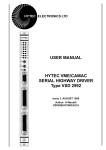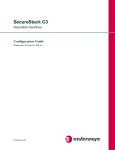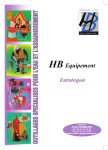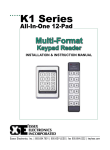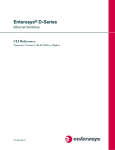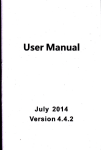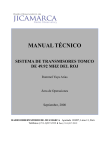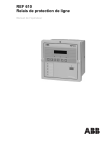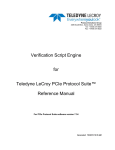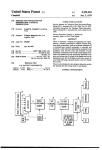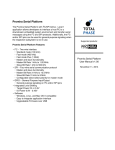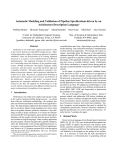Download (PCI 5992 USER GUIDE) - Hytec Electronics Ltd
Transcript
England HY TEC ELECTRONICS LTD USER MANUAL FOR THE HYTEC PCI/CAMAC SERIAL HIGHWAY DRIVER Type PCI 5992 PCI 5992 U PORT DIN D out Issue 4: March 2000 Author: H Wardell PCI 5992/UTM/G/X/2.0 CONTENTS:– Page . . . . . . . . 1.0 Product Summary 2.0 Setting up a System . . . . . . . . 2.1 Byte or Bit Serial . . . . . . 2.2 Clock Selection . . . . . . 2.3 Clock Speed . . . . . . . 2.4 Space Byte Insertion . . . . . 2.4.1 Read/Write Functions . . . 2.4.2 Control Function Space Bytes . 2.5 PCI passthrough Base Address . . . 2.6 PCI Interrupt Line . . . . . . 2.7 External Connections . . . . . 2.7.1 Serial Highway Connections . . 2.7.2 U–Port Connector . . . 2.7.3 Message Started . . . . Using the PCI 5992 . . . . . . . . 3.1 Insertion into the PC or workstation . . . 3.2 Initial State . . . . . . . 3.3 The Registers . . . . . . 3.3.1 Register 00 Condition Bits . . . 3.3.2 Register 04 12–Bit LAM Mask . . 3.3.3 Register 0C 12–Bit LAM Status . . 3.3.4 Interrupt Vector 08 . . . . 3.3.5 U–Port Settings Register 48 . . . 3.3.6 Command Register (Register 14 Write) . 3.3.7 Transmit Data (Register 18 Write) . . 3.3.8 Serial Status (Register 10 Read) . . 3.3.9 Demand Status (Register 24 Read) . 3.3.10 Read RXD Data . . . . 3.4 Test Facilities . . . . . . 3.4.1 LED Indicators . . . . . 3.4.2 Loop–Back Facility . . . . 3.4.3 Transmitted Command & Data Registers 3.4.4 Command FIFO . . . . . 3.4.5 Dump Store . . . . . PCI Bus Software Aspects . . . . . . . Appendix and Figures 1 to 9 . . . . . . References . . . . . . . . . 3.0 4.0 5.0 6.0 2 4 7 7 7 7 8 8 8 8 9 9 9 9 9 10 10 10 10 10 10 11 11 11 12 12 13 13 13 13 14 14 15 16 16 16 24 25 HYTEC Electronics Ltd HEAD OFFICE: 5 CRADOCK Road, READING, Berkshire. RG2 0JT ENGLAND. Tel: 0118 9757770 Fax: 0118 9757566 NORTHERN OFFICE: 64 AMY Street, LEICESTER, LE3 2FB. ENGLAND. Tel: 0116 2630250 Fax: 0116 2630399 Printed in England. Issue 3. Mar–99 Incorporated in ENGLAND No. 1246940 Registered office: 5 Cradock road, Reading, Berkshire, ENGLAND. RG2 0JT Our policy is one of continuous product development and the right is reserved to supply equipment which may vary slightly from that described. 3 1.0 Product Summary Serial Highway Driver Type PCI 5992 PCI Features Operates as a PCI Slave module. Operates as an Interrupter. Overall Interrupt Enable Bit. Vector Writable and Readable. Complies with CAMAC specification EUR6100E and I.E.E.E. 595. Bit Serial and Byte Serial Modes at up to 5MHz. Internal Crystal Controlled input with comprehensive dividing network. Separate Reply Buffer. 64 Word FIFO Demand Buffer. Lost Sync Indicator. 12 Bit Maskable LAM Register. Repeat Read Mode. Q–Scan Mode. Reply Timeout. Echo Mode. Readout of transmitted message. 64 ’Byte’ Test Message Generator with facilities for forcing errors. Module Booking mechanism for multi–master working. Dump Store for message analysis. Drive for Hytec U–Port Adaptor. Readout of U–Port Setting & Main/Backup Loop States. PCI 5992 U PORT DIN DOUT Product Description The Hytec PCI 5992 is a single short PCI module plus a passive plug converter box which transmits and receives signals on the CAMAC serial highway whilst being controlled via the PCI BUS. Bit serial and Byte serial ports for data and clock are provided for the transmission of command and the acceptance of reply and demand messages. Serial messages are initiated by loading command and data registers via the PCI bus using 32 bit words. Incoming messages are checked for transverse and longitudinal parity. The serial clock is controlled by a crystal source. The internal oscillator may be divided down from the source to give transmission rates of approximately 1kHz to 5MHz. A twelve–bit ”LAM” Status and ”LAM” mask register–set provide a comprehensive interrupt system which has a separate overall allow interrupt bit. The Lam status register may be cleared or selectively cleared and the Lam mask register can be written, cleared, selectively set and selectively cleared. The mask and all control registers are cleared at power up, or by a PCIbus reset, or by a programmed reset. 4 Operational Features Six registers provide communications between the PCI BUS and the Serial Highway. Message transmission is initiated by: 1. 2. Writing the command register with a serial Read or Command function or:– Writing the Write Data register whilst the Command register contains a serial Write function. Loading the Command register with a serial Write Command does not initiate transmission. The 24 Bit Serial Read Data may be read via the PCI bus as one 32 Bit word after the reply message has been received. Receipt of a reply or otherwise together with the state of the serial SX and SQ may be determined by reading the unit status register (offset – 00). The full status is obtained by reading offset 10. A new transfer should not be set–up until a reply has been received for the previous transmission. Two bits are provided in the command register so that a Q–scan mode may be utilised if the basic parameters, function, crate are the same. The two bits are MQ and MR. If MR is set, then a ’Read” to the module initiates a repeat message. The serial Command sent, is identical if MQ=0, but is varied if MQ=1 depending on the state of the serial Q(SQ). If SQ=1 then the serial address (SA) is incremented, whereas if SQ=0, SA is reset and the Serial station number (SN) incremented. If SN increments beyond 24, then the crate address is cleared and the new transmission made with crate = 0. This gives address not recognised on receipt back at the PCI 5992 which interrupts terminating the transfer. Timeout If 350mS elapses from the start of a message transmission and there has been no reply or unrecognised command message, the TIMEOUT signal is asserted which sets TMO LAM source. SHR also becomes true (SHR = RPL or TIMEOUT) and the RDY LAM source is set if/when CMD is true. Reply messages received after TIMEOUT is asserted are ignored. Addressing the Module The module is addressed in passthrough mode as a PIC slave with base address set by plug and play. The unit status register (00) contains a booking bit, which is automatically set following a read, if previously unset. The following table overleaf, gives the provisional register allocation for the ”passthrough offset addresses”. The main ”passthrough address” is available as base address register 1 in the configuration registers see section 4.0. 5 PCI 5992 REGISTER ALLOCATION OFFSET READ FUNCTION WRITE FUNCTION STATUS 2 BITS VALID 00 STATUS 04 LAM MASK 12 BITS VALID 08 VECTOR TOP UPPER 16 BITS VALID 0C LAM STATUS 12 BITS VALID 10 SERIAL STATUS 12 BITS VALID UNUSED WRITE READ 24 BIT DATA * WRITE 1C READ DUMPSTORE POINTER 10 BITS WRITE DUMP STORE POINTER 10 BITS 20 READ DUMPSTORE AND INC. POINTER 8 BITS ENABLE/DISABLE DUMPSTORE 1 BIT 24 READ DMD FIFD 12 BITS 28 READ CRATE ADD (IF LOOP BACK) 6 BITS 2C READ A (IF LOOP BACK) 6 BITS UNUSED 30 READ F (IF LOOP BACK) 5 BITS UNUSED 34 READ N (IF LOOP BACK) 5 BITS UNUSED 38 READ DATA (IF LOOP BACK) 6 BITS UNUSED 3C READ DATA (IF LOOP BACK) 6 BITS UNUSED 40 READ DATA (IF LOOP BACK) 6 BITS UNUSED 44 READ DATA (IF LOOP BACK) 6 BITS 48 READ UPORT 8 BITS 14 18 13 BITS VALID LAM MASK 15 BITS VECTOR WRITE TOP 16 BITS ONLY LAM STATUS 13 BITS UNUSED CNAF 22 BIT DATA 24 BIT DATA* WRITE TEST FIFA 8 BITS SET/CLR LOOPBACK 1 BIT UNUSED WRITE UPORT 3 BITS 4C UNUSED SPECIAL CLR, CLRS DMD, MR, TS. 50 UNUSED & EVERYTHING (PROG, RST) 54 UNUSED UNUSED All registers are 32 bits wide with unused upperbits set at 0. An exception is offset 08 where the vector top 16 bits is set. The bottom 12 bits is the LAM status with bits 12 – 15 indeterminate. *Read data is as received from the serial highway. *Write data is the message to be sent to the highway. To read out going data use 28 – 44 in loopback mode. 6 PCI 5992 Expanded Register Detail OFFSET 32 23 22 21 20 19 18 17 16 15 14 13 12 11 10 9 8 0 00 0< 16 BITS >0 04 0< 16 BITS >0 08 X< 16 BITS >X – 0C 0< 0 0 SM SSM SCM CLR – >0 0 0 16 BITS 0 – – 0 7 6 5 4 INT SE ACB BYT DMD LAM SHR XMR EN ERR 3 2 Q X 1 0 RDY BKD X X X X X X X X X X X X – – – – – – – – – – – – _ _ SE AD– DE– SCL ERR DMD XMR SHR TPE TMD LPE NR RR ERR SQ SX DE– M2 M1 RR SQ 10 0–0 0 14 0–0 0 18 0–X X X X X X X X X X X X X X X X X X X X X X X X 1C 0–0 0 0 0 0 0 0 20 0–0 0 0 0 0 0 24 0–0 0 0 0 0 0 0 0 28 0–0 0 0 0 0 0 0 0 0 0 0 0 0 2C 0–0 0 0 0 0 0 0 0 0 0 0 0 30 0–0 0 0 0 0 0 0 0 0 0 34 0–0 0 0 0 0 0 0 0 0 38 0–0 0 0 0 0 0 0 0 0 3C 0–0 0 0 0 0 0 0 0 0 0 0 0 0 40 0–0 0 0 0 0 0 0 0 0 0 0 44 0–0 0 0 0 0 0 0 0 0 0 48 0–0 0 0 0 0 0 0 0 4C 0–0 0 0 0 0 0 0 50 1–1 1 1 1 1 1 54 1–1 1 1 1 1 1 0 0 0 C32 C16 C8 0 0 C4 C2 0 C1 0 0 0 0 0 0 0 MQ MR N16 N8 0 0 0 0 0 0 0 0 0 C32 C16 C8 N4 N2 C4 N1 A8 C2 A4 C1 A2 A1 F16 F8 F4 SX ERR F2 RST DMD RST FIFO PROG RST CLR MR LAM MASK VECTOR LAM STATUS SERIAL STATUS WRITE CNAF R/W DATA 0 0 0 X X X X X X X X X X R/W DMP PNTR 0 0 0 X X X X X X X X READ DUMPST 0 0 0 SG– SG– SG– SG– SG– M2 C32 C16 C8 L5 L4 L3 L2 L1 C2 C1 READ DMDS 0 0 0 X X X X X X X X READ CRATE 0 0 0 0 X X X X X X X X READ A 0 0 0 0 0 0 X X 1 X X X X X READ F 0 0 0 0 0 0 0 X X 1 X X X X X READ N 0 0 0 0 0 0 0 X X X X X X X X RDTX1 DATA 0 0 0 X X X X X X X X RDTX2 DATA 0 0 0 0 0 X X X X X X X X RDTX3 DATA 0 0 0 0 0 0 X X X X X X X X RDTX4 DATA 0 0 0 0 0 0 0 0 X X X X X X X X READ UPORT 0 0 0 0 0 0 0 0 0 0 0 0 0 1 1 1 1 1 1 1 1 1 1 1 1 1 1 1 1 1 1 UNUSED 1 1 1 1 1 1 1 1 1 1 1 1 1 1 1 1 1 1 UNUSED C4 0 X X X *0 Is always 0 *X Is 0 or 1 *1 Is always 1 Offset – 4C F1 STATUS 2 1 7 3 CLR Serial Interface DMD FIFO CLRS Command FIFO Reboot XYLINX CLRS Repeat Bit 7 WRITE ONLY 2.0 Setting–up a System 2.1 Byte or Bit Serial The selection of Bit or Byte Serial is dependant on the site circumstances. If the distances are great, then the cable costs and the interbit skew can be excessive, and therefore Bit Serial might be chosen. If distances are short, then normally Byte Serial would be chosen to increase the system speed. Other factors may govern the choice such as the use of U–Port Adaptors which may only operate in Bit Serial mode. Whatever the reason, the choice must be made, and the links can be set as follows:– For Bit Serial connect LK1 Pins 1 to 2. For Byte Serial connect LK1 Pins 2 to 3. Note: All Serial Crate Controllers must also be set to the same mode. For 4 byte waits before sync lost is reported, LK2 Pins 1 to 2. For 8 byte waits before sync lost is reported, LK2 Pins 2 to 3. 2.2 Clock Selection There is no choice of clock source on this module. The source is an Internal crystal clock operating at 10 MHz. 2.3 Clock Speed The clock speed and hence the system speed is largely determined by setting the amount by which the selected clock is divided down. Selection is by links on SW2 and SW3, see FIG 1. Select SW2 3 4 5 3 4 5 3 4 SW3 2 2 Frequency – 5MHZ 2.5MHZ 1MHZ 500kHz 250kHz 100kHz 50kHz 25kHz 5 3 4 2 3 3 3 4 4 4 5 5 5 5 1kHz 8 10kHz 5kHz 2.5kHz 2.4 Space Byte Insertion 2.4.1 Read/Write Functions Normal operation with standard serial crate controllers. LK4, 2 – 3. In order to allow for the serial crate controller to reply, sufficient time must be allowed for it to complete its in–crate or internal cycle. Hence the transmitted message is padded out with a number of space bytes. For normal data messages, the minimum suggested number is in the table that follows:– Byte Rate Mbytes/Sec Write/Test Function Read Function < 0.5 * 8 4 0.5 – 1.5 9 4 1.5 – 2.0 10 6 2.0 – 2.5 10 6 2.5 – 3.0 11 7 3.0 – 3.5 11 7 3.5 – 4.0 12 8 4.0 – 4.5 13 9 4.5 – 5.0 ** 14 10 * Note: All Bit Serial transfers are in this range. ** Note: Correct SCC operation is not guarenteed above 5Mhz. This is based on the formula given in EUR6100(1982); S = N(OP) + N(REP) + 1 where N(OP) and N(REP) are the number of received space bytes required to cover the maximum dataway cycle time of the SCC and its reply. N(OP) is the next integer above T(OP) / T(byte) where T(OP) the maximum data cycle time (assumed 1.2uS) and T(byte) is the minimum byte period of the system. Note that larger numbers may be safely used at the expense of the system speed. The relevant numbers are set in binary format on DIL Switch SW1, the maximum is 16, see FIG 1. N.B. ”ON’ equals 0, therefore to set ’1’, the relevent switch is set ”off”. NOTE:– The formula used, assumes that the crate controller replies immediately after the first space byte. If it does not then the figures may be too low, hence if DERR and/or LPE status bits are present. Increase the number of space bytes by 1 for a write and 2 for a read. Space bytes when operating with ACB serial crate controllers. LK4, 1 – 2. The CAMAC Serial Highway was specified assuming only one Serial Crate Controller per crate. Allowance was made for other types of controller being present by making them give up the crate if the Serial Crate Controller raised ACL on the ACB connector. This means that the serial Crate controller is not held up for any long periods. The Serial Crate Controller was then given a space to reply in, being defined by a number of space bytes. After the space bytes have finished, the command is suspended and the Serial Highway Driver and the rest of the loop is able to accept and send demands around the system, with any unfulfilled command being finally terminated 9 by the 350mS time–out delay. If a Serial Crate Controller with an ACB connector is produced, then multiple controllers may be present in a crate and each must use the Request/Grant system to gain access. This means that any one controller may not be able to reply in the allowed space and hence the system will either not work or must be slowed down considerably. A way around this is to allow the space to expand until a reply is received from the addressed controller. This is what has been done with the PCI 5992. If ACB mode is selected, space bytes are generated until a reply is received. There is of course a possible problem in that If no reply is received, then all demands are blocked for the 350mS time–out period. Things are not quite as bad as they may seem at first sight, because the problem only arises if a SCC doesn’t reply having accepted the message. If no SCC accepts the message, then the command will return around the loop and be received by the Serial Highway Driver. ”Address not Recognised” will be raised, which will terminate the command and hence the space bytes. The mode may also be used with single crate controllers to extend the range of each speed selection and hence improve the throughput. 2.4.2 Control Function Space Bytes Write control functions with N30 present act on the SCC itself, and may cause reconfiguration. This can typically take 100mS. Provision is made to extend the number of space bytes to those contained in 120mS if it is required to await a true reply, rather than accept the longer time–out period. The decision is made by changing LK3 as follows. (See FIG 1.) LK3 LK3 1 to 2 2 to 3 Delay IN Delay OUT 2.5.0 PCI Passthrough Base Address All working addresses are offsets of passthrough address 1. See section 4. 2.6 PCI Interrupt Line The unit will interrupt on INTA only and should be set up to interrupt on mailbox 2. See section 4. 2.7 External Connections 2.7.1 Serial Highway Connections The unit may operate with one of three configurations illustrated in FIG 2. (a) Two cable Byte mode:– This may be considered the normal mode. A 12 pair cable runs from the output ’D’ connector to the first SCC input ’D’ connector. A 12 pair cable runs from the output ’D’ connector of the SCC, either to another SCC input ’D’, or back to the input ’D’ connector of the SHD unit, ie, the final SCC output returns to the SHD unit. (b) Two cable Bit mode:– 10 As above but the cable may be reduced to 2 pairs for economy. (c) Single cable with a minimum of four pairs:– In this case a change–over plug is inserted in the output plug of both the last SCC and the SHD unit, the remote clock and data return down the same cable. 2.7.2 U–Port Connector The unit may be used to control and monitor a HYTEC UPA 0542 Master Fibre Optic U–Port Adaptor, detailed data sheets are available by request. This is accomplished via a 15 way socket labelled ’U–Port’. Note that U–Ports may be manually set and may still form part of the Serial Highway system without being controlled from the SHD unit. 11 3.0 Using the PCI 5992 3.1 Insertion into the P.C. or Workstation The unit should be plugged into any spare PCI slot. 3.2 Initial State With the unit plugged in, cables attached to all units in the serial loop and all units powered, the ’SYNC’ LED on the front panel should be lit. Other LEDs should normally be ’OUT’. If the ’SYNC’ LED is not lit, then no clock is being received if in byte mode, or no ’wait’ bytes are being detected if in serial mode. Check:– 3.3 All cables are present. All units are powered. All units are set to the same mode. The clock frequency is slow enough for the size of loop. It would be advisable to start with a slow clock speed on new installations. The Registers The following assumes a working unit together with working modules in association. Fault finding and test procedures are delt with later in this document. All offsets are from the base register address 1. Loaded at bootup into offset 18 of the configeration register see section 4.0. Control Registers offset 0016 – 1016 and register 4816 may be considered as control registers. The most important of these is 0016, this contains various fixed bits plus a booking bit (bit 0) useful for multiuser environments; the interrupt enable bit (bit 4), and copies of the most important of the LAM Status bits. The unit may thus be operated on interrupts or by looping on this address until the required condition arises. 3.3.1 Register 00 Condition Bits Bit 0 Bit 1 Bit 2 Bit 3 Bit 4 =1 =1 =1 =1 =1 Bit 5 = 1 Bit 6 = 1 Bit 7 = 1 Bit 8 = 1 Bit 9 = 1 Bit 10= 1 Bit 11= 1 BUSY: Set after read if not set, cleared by Bit 0 = 1. (Booking bit). RDY: Complementary to BUSY ie. available. X response of last command. Q response of last command. INTEN: overall interrupt enable, set by writting Bit 4 = 1. Cleared when vector written to mail box 2 following an interupt. XMR: Command has transmitted, cleared by new command. SHR: XMR present and reply received or time – out occured. Cleared by new command. LAM: one or more masked LAMs set, cleared when 04 bit is cleared, or OC bit is cleared. SERR: an error occured in the SYNC. DMD: A demand message has been received. Cleared when OC bit is cleared. Byte mode set. Cleared if bit mode set by link. ACB mode set, cleared if normal mode set by link. 3.3.2 Register 04 12–Bit LAM Mask This register determines which of the 12 LAM status bits is allowed to generate an interrupt, assuming the overall enable bit is set. Set and cleared by writing to 04. Bit 12= 1 Clear all 12 Bit 13= 1 Selective clear mask bit as specified Bits 0 – 11 Bit 14 = 1 Selective set mask bit as specified Bits 0 – 11 3.3.3 Register 0C 12–Bit LAM Status These bits are allowed to set interrupts if the corresponding bit in 04 is set. Bit 0 = 1 Bit 1 = 1 Bit 2 = 1 Bit 3 = 1 Bit 4 = 1 Bit 5 = 1 Bit 6 = 1 Bit 7 = 1 Bit 8 = 1 Bit 9 = 1 Bit 10= 1 Bit 11= 1 Note: SQ, the Q response to the last serial command was 0. SX, the X response to the last serial command was 0. ERR, an error was detected in the last command by an addressed SCC. Usually /SQ and /SX will also be set as no dataway cycle will have taken place. DERR, indicates that an error was detected by the addressed SCC in the previous message addressed to it. ADNR, indicates that the crate address was not recognised by any SCC on the Serial Highway. It is detected by the PCI 5992 detecting an output message with /M1 and /M2 both present at its input socket. LPE, indicates that a linear parity error was a detected in the reply message. TMO, indicates that no reply message was received in the 350mS since the last command message was sent. TPE, indicates that a transverse parity error occurred on an incoming message. Wait byte TPE are ignored. SHR, indicates that a command sequence has completed, ie, a good reply has been received, a time–out has occurred or the command has returned as address not recognised. XMR, indicates that the unit has finished transmitting the last command. DMD, indicates that a demand message has been received since the status was last cleared. SERR, indicates that the unit lost synchronisation for at least four byte times. All of the above bits are bit cleared or cleared by writing register 0C. Bit 12 = 0 Clear all Bit 12 = 1 Clear bit as specified in Bits 0 – 11. 3.3.4 Interrupt Vector Reg 08 The 32 bit vector used when interrupting is loaded by writing to the upper 16 Bits of register 0C. It may be examined by reading register 08. The lower 16 bits will read as zero. 3.3.5 U–Port Settings Reg 48 Register 48 controls and monitors the state of a Hytec U–Port Adaptor if fitted. A write of register 48 lower four bits sets the available modes. A read of register 48 confirms the current settings as written and also monitors the three lines which describe the actual connection state at the adaptor, ie, MAIN LOOP Operable, BACK–UP Operable and internal or external clock. For full information as to the use of these lines, please refer to the Hytec U–Port Adaptor manuals. 13 3.3.6 Command Register (Register 14 Write) This 32 bit register is split into sections as follows:– Bit 0 – 4 Function F1, F2, F4, F8 and F16 of the CAMAC Command to be used in the remote crate. Bit 5 – 8 Subaddress A1, A2 ,A4 and A8 of the CAMAC Command to be used in the remote crate. Bit 9 – 13 Station number N1, N2, N4, N8 and N16 of the CAMAC Command to be used in the remote crate. Bit 14 MR, this is a special bit which when set causes an automatic repeat of the current read command (if any) immediately following a read of the lower byte of register 1A. A block read is thus possible on the same location. Bit 15 MQ, this is a special bit which when set in conjunction with MR, causes an automatic repeat read with the Subaddress advanced by one if the received Q=1. If Q=0, then the Subaddress is cleared to zero and the station number advanced by 1 before doing a repeat read. This forms the Q–Scan of the crate. When the station has incremented to 24, then the crate address is made zero which returns as ADNR and terminates the transfers. Bit 16 – 25 Crate address. Note: 1 If MR and MQ are both zero then only a single transfer takes place. Note: 2 If the Function specified is a read then the message is transmitted on receipt register 14, ie, when the Function is loaded. If the Function is a write, then the message is transmitted when the data has been loaded. Note: 3 This register forms part of the message sequence so that the data can not be read back under normal operation. 3.3.7 Transmit Data (Register 18 Write) Bits 0 – 23 of register 18 form bits 1 – 24 of the CAMAC data to be sent to the remote crate. If a write command is present in register 14 then transmission commences on receipt of this data. Note, a block transfer to the same CAMAC location therefore only requires the data to be loaded. The command information may be re–used. Serial Highway Status: Registers 10 and 24 are status registers containing information read from the Serial Highway. They must be used in conjunction with the LAM Status Register (0C) and/or the Device Status Register (00) in order to confirm whether they are valid. 3.3.8 Serial Status Register (Register 10 Read) This register contains the status information which was received in the last reply message from the last addressed SCC. It is only valid after the setting of RDY in the LAM Status Register (OC), but remains true until a new command is issued. It is necessary therefore, to ensure that RDY is cleared prior to issuing a new command or initiating one if in repeat mode. Bits 6 – 11 Crate address of replying SCC. Bit 0 = 1 ERR, an error was detected in the command message just terminated. Bit 1 SX, X response to the command just terminated, always 0 if ERR set or M1 = M2 = 0. 14 Bit 2 Bit 3 Bit 4 & 5 SQ, Q response to the command just terminated, always 0 if ERR set or M1 = M2 = 0. DERR, SCC had an error in the previous command addressed to it. M1 and M2 copy of the command/reply definition bits received in the second byte of the serial reply message. 3.3.9 Demand Status (Register 24 Read) This register (24) contains the demand information received from the Serial Highway via an unsolicited demand originating in one of the possible 64 crates. It is not a true register, but is the current output from a 64 word FIFO memory. Because of this, the data may only be read once and is only valid if DMD is set in the LAM Status or Unit Status. It must not be read on the fly, but only in answer to a DMD being set. This DMD should be cleared before reading the DMD status. Reading the DMD status clears the current information and will reset DMD if a further DMD is outstanding. Bits 0 – 5 Crate address of the originating SCC. Bits 6 – 10 Graded LAM describing the source of the interrupting device. Bit 11 M2 as received, should be 1 for a true DMD message. 3.3.10 Received Data Register 18 read contains the data received from the addressed crate for the last transmitted Serial Highway command. The data is only valid if the last command has terminated and a reply has been received, ie, RDY has been set. The data remains valid until a new command starts to transmit. It is therefore essential that the RDY status is cleared before issuing a new command or reading the registers if MR is set, as the reading of the data register triggers the new command. 3.4 Test Facilities The following facilities have been added to aid testing and fault finding:– a) A loop–back facility to by-pass the external Serial Highway. b) Read back of command and data 6–bit bytes with the corresponding parity and delimiter bit, ie, 8–bits. c) A 64 byte command generator FIFO store. d) A 1kbyte DUMP store which can be set to monitor the incoming 6–bit data patterns received by the unit. 3.4.1 LED Indicators Four LED indicators have been provided to enable the operator to visually observe the operation of the unit, they are as follows:– a) The PWRD LED indicates that the unit is powered. b) SYNC monitors the state of synchronisation of the unit. If present, it indicates that the unit is receiving clock pulse if in Byte–Mode or detecting ’wait’ bytes or synchronised data if in Bit–Mode. c) MSG indicates that a serial command has commenced transmission. It is present for approximately 100mS following the first byte of the command sequence. 15 d) ADD indicates that the unit is being addressed from the PCI bus. Each access results in the LED being illuminated for approximately 100mS. 3.4.2 Loop–Back Facility NB: UNIT SHOULD BE SET TO BYTE MODE. With so many units possibly connected on a Serial Highway, it is necessary to confirm that the fault, if any, is within the PCI 5992 or external to it. A facility to externally exclude the Serial Highway and the drivers and receivers of the PCI 5992 has been provided. The loop–back (LB) is made by connecting the internal source of signals to the received signals path without going via any cables at the same time ”Wait Bytes” are continuousley transmitted on the main loop. The facility is activated by writing bit 0 = 1 in register 28 and cleared by writing bit 0 = 0. In this mode any command will be returned as if the external crate did not recognise the crate address, ie, ADNR will be set. The facility becomes extremely powerful when used with the following facilities. 3.4.3 Transmitted Command and Data Registers The command data and write data when loaded is split up into the sequencing registers in the 6–bit bytes to be transmitted. These are only allowed on to the internal bus at the correct time as the bus is normally transmitting wait byte in the quiescent state. Any switching whilst in the normal operating mode would therefore create errors all around the serial loop. The facility to read back this data in the form in which it would be transmitted is therefore limited to the LB state. With the unit set to Loop–Back (LB) then the 8–bit pattern which would be transmitted may be selected as follows:– 16 Register 28 Bit 0 – 6 Bit 7 Bit 8 Register 2C Bit 0 – 4 Bit 5 = 1 Bit 7 Bit 8 Register 30 Bit 0–3 Bit 4 = 0 Bit 5 = 0 Bit 7 Bit 8 Register 34 Bit 0 – 4 Bit 5 = 1 Bit 6 Register 38 Bit 0 – 5 Bit 6 Bit 7 Register 3C Rd Tx Crate Address Crate Address. Delimiter bit should be 0. Transverse parity bit making odd parity. Rd Tx N N – Station number in the remote crate. Always 1. Delimiter bit should be 0. Transverse parity. Rd Tx A A – Subaddress in the remote crate. Message identifier M1 = 0 for command. Message identifier M2 = 0 for command. Delimiter bit should be 0. Transverse parity. Rd Tx F F – Function to be used in the remote crate. Always 1. Delimiter bit should be 0. Rd Tx Data 19 – 24 Tx Data bits 19–24 for the remote crate. Delimiter bit should be 0. Transverse parity bit. Rd Tx Data 13 – 18 Bit 0 –5 Bit 6 Bit 7 Tx Data bits 13 – 18. Delimiter bit should be 0. Transverse parity bit. Register 40 Bit 0 – 5 Bit 6 Bit 7 Rd Tx Data 7 – 12 Tx Data bits 7 – 12. Delimiter bit should be 0. Transverse parity bit. Register 44 Rd Tx Data 1 – 6 Bit 0 – 5 Bit 6 Bit 7 Tx Data bits 1 – 6. Delimiter bit should be 0. Transverse parity bit. 17 3.4.4 Command FIFO A 64–byte 8–bit Command FIFO is available for generating test message which may be set up containing errors if required. The FIFO is arranged to substitute for the message command and data registers, and because it changes over without discontinuities, it can be used either on LB or with the serial interface complete. Messages not normally issued by the Serial Highway driver can thus be sent around the loop; ie, commands, demands, truncated commands, replies, wait bytes with parity errors or incomplete messages. The FIFO is set up as follows:– Register 24 write. Starting with a ”wait” byte load each 8–bit Serial Highway byte of the required message until complete. See formats in FIGs 4 – 9 in the appendix. The final byte for a command message must be correct longitudinal parity followed by as many space bytes as required plus at least two wait bytes (one is the end byte). For other messages at least one wait byte should be located following the delimiter byte. When complete, the FIFO contents are transmitted by writing zero or any other read to register 14. No crate address is required as the information is not used. The FIFO will then take over and release when transmission is complete. Note that only one command message should be loaded if correct operation is required. 3.4.5 Dump Store Another facility is a 1kbyte Dump Store which may be set up to receive up to 1k worth of the 8–bit bytes received from the Serial Highway for analysis. The store only collects non–wait bytes except for the wait byte immediately following a message sequence. It is set up by writing the address pointer to zero. Write register 1C = 0, and then the store is started by Enable Dump Store Register 20 bit 0 = 1. Collection is stopped by writing register 1E bit 0 = 0. The pointer should then be read by register 1C read, and the number stored. This represents the valid number of entries for the sequence. The pointer should then be reset, register 1C = 0, and the store read and the pointer incremented by register 20 read for valid number of entries. The Dump Store may be used at any time. 18 4.0 PCI Addressing The unit makes use of a specialised PCI compliant ASIC, to communicate with the PCI Bus. All ”PCI”commands are dealt with by the device within the eight clock pulse time–out period for reading and writing of the configuration and operational registers. Two sets of base addresses are loaded by plug and play at boot – time following requests lodged via the configuration PROM. Base address 0 gives the base address for the configuration and operational registers. Base address 1 gives the base addresses for the passthrough region and thus the offsets for the module control registers. 4.1 Configuration Registers This consists of a 256 byte configuration Reader space, some of which is mandatory for the compliant device. Part of this space is read only and is sourced by a PROM to enable the ”plug and play” facility. The PROM may be extended as an expansion ROM, not currently used. Configuration Registers:– These are read by the M/C bios system on power up and are registered by the Address Offset 00H 04H 08H 0CH 10H 14H 18H 1CH 20H 24H 28H 2CH 30H 34H 38H 3CH Register Name Outgoing Mail Box 1 Outgoing Mail Box 2 Outgoing Mail Box 3 Outgoing Mail Box 4 Incoming Mail Box 1 Incoming Mail Box 2 Incoming Mail Box 3 Incoming Mail Box 4 FIFO Register Port (Bi–directional) Master Write Address Master Write Transfer Count Register Master Read Address Register Master Read Transfer Count Register Mail Box Empty/Full Status Interrupt Control/Status Register Bus Master Control–Status Register operating system. 19 Comments Unused Unused Unused Unused Unused Interrupt Register Unused Unused Unused Unused Unused Unused Unused MB2 Only Set to MB2 Unused 4.2 Operational Registers The operational registers are again registers contained within the PCI Bus ASIC. They consist of 16 Registers (D words) located at the address space specified by the Base Address Register 0. Configuration Address Offset 00H – 01H 02H – 03H 04H – 05H 06H – 07H 08H 09H – 0BH 0CH 0DH 0EA 0FH 10H – 27H 28H – 2FH 30H 34H – 3BH 3CH 3DH 3EH 3FH 40H – FFH Register Name Hytec Identification (1196H) Device Identification (5992) PCI Command Register PCI Status Register Revision Identification Register Class Code Register Cache Line Size Register Master Latency Timer Header Type Built–in Self Test Base Address Registers (0–5) Reserved Expansion ROM Base Address Reserved Interrupt line Interrupt Pin Minimum Grant Maximum Latency Not used Comments PCI Registered No. PCP’s Ident Unclassified N/A N/A N/A O & I Used Not Currently Used N/A N/A 4.3 Expansion ROM The contents of this ROM which is an extension of the configuration ROM is to be determined. It is addressed as from the Expansion ROM Base Address Register and including the 256 bytes configuration area is a maximum of 64K bytes 4.4 Drivers Suitable drivers will be avaliable for:– Windows 98 Windows NT V.M.S. 4.5 Support Software Support software is under review and will be specified at a later date. . 20 5.0 Appendix Frequency Selection 2 SW2 2 SW3 LK2 3 1 4 5 3 1 5 1 2 4 SYNC. LOST DELAY 3 XILINX ACB/NORMAL 40IDE CONTROL FUNCTION DELAY. 3 2 1 LK4 LK3 3 2 1 68 WAY SPROM AMCC ’MATCH MAKER’ 1 2 3 LKI BIT / BYTE Selection FIG. 1 21 ON R8 4 2 R1 W8 4 2 W1 OFF E PROM SPACE BYTES ON = 0 OFF = 1 D O U T CLK OUT SCC(1) SCC(2) D D CLK I N DATA 8–Bits D D I N CLK IN I N D DATA 8–Bits O U T O U T DATA 8–Bits VSD 2992 BYTE SERIAL D O U T CLK OUT SCC(1) SCC(2) D D CLK I N DATA 1–Bit D D I N CLK IN DATA 1–Bit I N D O U T O U T DATA 1–Bit VSD 2992 BIT SERIAL CLK IN D O U T D I N CLK OUT DATA OUT DATA IN SHORTING PLUG SCC(1) SCC(2) D D I N I N D D O U T O U T VSD 2992 SINGLE ENDED BIT SERIAL FIG 2. 22 SHORTING PLUG PCI 5992 Serial Highway Connectors Output Socket (type DB–25S) Input Plug (type DB–25P) D–IN 1 2 3 4 5 6 7 8 9 10 11 12 13 14 15 16 17 18 19 20 21 22 23 24 25 GND GND Bit Serial Data I/P Bit Serial Data O/P Byte Serial Data I/P Byte Serial Data O/P Clock O/P Clock I/P NU NU Fig 3. PCI 5992 U–Port Connector Socket Type 1.5:1 D Connector 1 2 3 4 5 6 7 8 9 10 11 12 13 14 15 EXTCLK GND BS3 MAIN GND BS2 BACK GND BS1 Fig 4. 23 1 2 3 4 5 6 7 8 9 10 11 12 13 14 15 16 17 18 19 20 21 22 23 24 25 D–OUT MSB 8 7 6 b 0 SC32 b 0 0 0 b 0 1 b 0 1 b 0 SW24 SW19 BYTE 5 * b 0 SW18 SW13 BYTE 6 * BYTE 7 * BYTE 8 * 5 4 3 2 LSB 1 SC1 HEADER BYTE SA1 BYTE 2 SF16 SF1 BYTE 3 SN16 SN1 BYTE 4 SA8 b 0 SW12 SW7 b 0 SW6 SW1 b 0 c c c 1 0 1 1 1 c 1 c c 1 1 b = Odd Byte – Parity Bits. c = Even Column – Parity Bits. * Bytes 5,6,7,8 included if SF16 = 1 and SF8 = 0. SUM BYTE SPACE BYTES AS REQUIRED 1 0 1 1 1 1 1 1 1 1 1 0 0 0 0 0 Fig 5. MSB 8 7 6 0 5 4 3 2 M 0 * FUNCTION 0 * STATION NUMBER I Command Message: Bit Assignments LSB 1 CRATE ADDRESS 0 END BYTE HEADER BYTE SUB–ADDRESS 0 WRITE DATA 0 WRITE DATA 0 WRITE DATA 0 WRITE DATA 0 COLUMN PARITY 0 SPACE COMMAND SPACE 1 END 7 6 b 0 SC32 1 1 1 5 4 3 2 LSB 1 SC1 0 0 0 0 0 END BYTE Truncated Command Message: Bit Assignments WRITE DATA (if required) MSB 8 SUM BYTE 7 6 5 4 3 2 0 CRATE ADDRESS 1 END LSB 1 DELIMITER BITS BYTE PARITY BITS Truncated Command Message: Field Assignments END BYTE DELIMITER BITS BYTE PARITY BITS * Reserved Bits. MI = Message Identifier Field. HEADER BYTE b = Odd Byte Parity Bit SPACE BYTES AS REQUIRED 0 MSB 8 Fig 6. Command Message: Field Assignments 24 HEADER BYTE END BYTE MSB 8 7 6 b 0 SC32 b 0 1 b 1 c 5 4 3 2 SGL5 c c c c LSB 1 SC1 HEADER BYTE SGL1 BYTE 2 c ENDSUM BYTE b = Odd Byte Parity Bits. c = Even Column Parity Bits. Demand Message: Bit Assignments MSB 8 7 6 0 0 1 5 4 3 2 LSB 1 CRATE ADDRESS MI SERIAL GRADED L COLUMN – PARITY DELIMITER BITS BYTE PARITY BITS HEADER BYTE SGL BYTE ENDSUM BYTE MI = Message Identification Field. Demand Message: Field Assignments Fig 7. 25 Table: Length of Command/Reply Transactions Number of Bytes Function Field Operation Read Control Write F16 F8 0 0 0 1 1 1 1 Command from Header to SUM Inclusive Reply from Header to ENDSUM Inclusive Command/ Reply Transaction 5 7 12* 5 3 8* 9 3 12* 0 * Minimum length, assuming that Reply Header is transmitted by SCC as first SPACE byte is received, and ENDSUM is transmitted as END byte is received. Table: Contents of Message Identification Field MI–Field Message M2 M1 Command 0 0 Reply 0 1 Demand 1 – FIG 8. 26 MSB 8 7 6 b 0 SC32 b 0 0 b 0 SR24 SR19 BYTE 3 * b 0 SR18 SR13 BYTE 4 * b 0 SR12 SR7 BYTE 5 * b 0 SR6 SR1 BYTE 6 * b 1 c 5 4 3 2 LSB 1 SC1 1 c DERR SQ c c SX ERR c c HEADER BYTE BYTE 2 b = Odd Byte – Parity Bits. c = Even Column – Parity Bits. * Bytes 5,6,7,8 included if SF16 = 1 and SF8 = 0. ENDSUM Byte Reply Message: Bit Assignments MSB 8 7 6 0 0 M 5 4 3 2 LSB 1 CRATE ADDRESS HEADER BYTE I STATUS BYTE STATUS 0 READ DATA 0 READ DATA 0 READ DATA 0 READ DATA 0 COLUMN PARITY MI = Message Identifier Field. READ DATA (if required) ENDSUM BYTE DELIMITER BITS BYTE PARITY BITS Reply Message: Field Assignments Fig 9. 27 6.0 References EUR4100 CAMAC Specification 1969ON. EUR6100 Serial Highway and Serial Crate Controller Type L–2. HYTEC Serial Crate Controller SCC 2401. HYTEC Master Dual Fibre–Optic U–Port Adaptor UPA542. HYTEC Slave Dual Fibre–Optic U–Port Adaptor UP541. HYTEC Serial Highway Driver SHD 992 (CAMAC : CAMAC). HYTEC Serial Highway Driver VSD 2992 (VME; CAMAC). IEEE 595 28




























